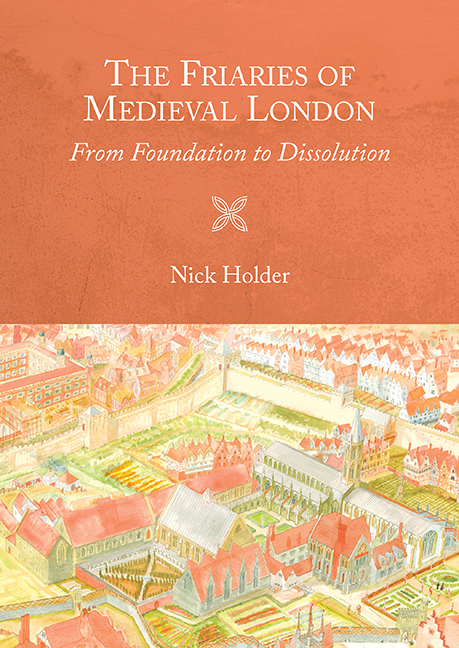Book contents
- Frontmatter
- Contents
- List of Illustrations and Tables
- Contributors
- Acknowledgements
- Abbreviations
- Introduction
- Part I The Nine London Friaries
- 1 The First Black Friars in Holborn, c. 1223–86
- 2 The Second Black Friars, 1275–1538
- 3 The Third Black Friars at St Bartholomew's, 1556–9
- 4 Grey Friars, 1225–1538
- 5 White Friars, c. 1247–1538
- 6 Austin Friars, c. 1265–1538
- 7 Crossed Friars, c. 1268–1538
- 8 Sack Friars, c. 1270–1305
- 9 Pied Friars, 1267–1317
- Part II The London Friars and their Friaries
- Conclusions
- Timeline
- Bibliography
- Index
- Miscellaneous Endmatter
7 - Crossed Friars, c. 1268–1538
from Part I - The Nine London Friaries
Published online by Cambridge University Press: 16 May 2018
- Frontmatter
- Contents
- List of Illustrations and Tables
- Contributors
- Acknowledgements
- Abbreviations
- Introduction
- Part I The Nine London Friaries
- 1 The First Black Friars in Holborn, c. 1223–86
- 2 The Second Black Friars, 1275–1538
- 3 The Third Black Friars at St Bartholomew's, 1556–9
- 4 Grey Friars, 1225–1538
- 5 White Friars, c. 1247–1538
- 6 Austin Friars, c. 1265–1538
- 7 Crossed Friars, c. 1268–1538
- 8 Sack Friars, c. 1270–1305
- 9 Pied Friars, 1267–1317
- Part II The London Friars and their Friaries
- Conclusions
- Timeline
- Bibliography
- Index
- Miscellaneous Endmatter
Summary
THE early history of the religious order known today as Crosiers – the Canons Regular of the Holy Cross – is not at all clear due to a lack of surviving documentary evidence, particularly for the order in the thirteenth and fourteenth centuries. There was almost certainly a small and mixed religious community of canons, laymen and laywomen in the early thirteenth century at Clairlieu in the diocese of Liège (modern Belgium). This group lived a communal religious life (including observation of a monastic daily liturgy); they would have offered hospitality, and they may also have preached and heard confession. As the group gradually solidified into a more formal religious order in the first half of the thirteenth century, they (like many other small religious orders) were not specifically identifiable as friars or canons. They broadly followed Dominican statutes but they did not adopt the strict mendicant ideal of poverty. The fratres sancte crucis, brethren of the Holy Cross, founded their first house in England in the 1240s at Whaplode in Lincolnshire, founding a second house in London about two decades later. In England these friar-like preaching canons were generally assumed to be friars. Furthermore, the English pronunciation of their alternative name, cruciferi, caused them to be commonly known as Crutched or Crouched friars, rather than the more correct translation of Crossed friars; the limited evidence suggests that they themselves preferred the latter. Given the English tendency to describe religious according to their clothes (White monks, Black friars …), the description of these friars as crutched or crouched rather than crossed might suggest that the English brethren did not in fact have as prominent an image of the crucifix on their scapular as their Continental counterparts.
The Crossed friars were one of the smallest of the London friaries, although they were probably more numerous than the short-lived order of Pied friars in the thirteenth century (Chapter 9: Pied Friars, 1267–1317). In the late thirteenth century they numbered twentynine friars, half the number of London Carmelites and only a third of the number of London Dominicans.
- Type
- Chapter
- Information
- The Friaries of Medieval LondonFrom Foundation to Dissolution, pp. 142 - 159Publisher: Boydell & BrewerPrint publication year: 2017



